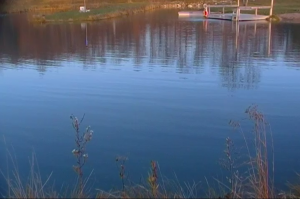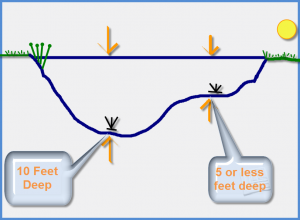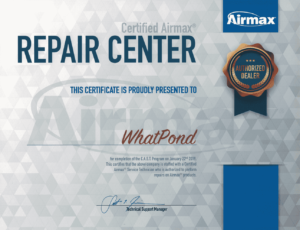 Winter Pond Aeration is a little different from aerating the pond all summer long, in fact if you choose not to aerate during winter it is your option. Since aerating all summer long we have built up a bank of oxygen from top to bottom and expelled the toxic gasses building in the bottom of pond.
Winter Pond Aeration is a little different from aerating the pond all summer long, in fact if you choose not to aerate during winter it is your option. Since aerating all summer long we have built up a bank of oxygen from top to bottom and expelled the toxic gasses building in the bottom of pond.
Why would we aerate during winter? Ice is generally no problem as the aquatic plants still receive sunlight and are able to stay alive to produce a small amount of oxygen. It’s when the snow covers the pond problems do arise. Without sunlight the plants can’ live, they’ll die off, decay, creating more muck and toxic gasses at the bottom of the pond.
If the current aeration system is still running and the water temperature has dropped to 50 degrees. There is the option to turn off the system completely or shut down all but one diffuser and move one diffuser to the dock, deck, shelf or the aquatic plant area that you want to keep alive. This allows sunlight to the plants, toxic gasses to escape, and air to water oxygen transfer on the open water.
When moving the diffuser for the sake of keeping an ice free area, position it at a place of half the depth of the pond. This will help prevent super cooling of the entire pond depth and the chance of hurting the fish cooling the water below what they can handle. Water Gardens and small Koi Ponds place the stone or rubber membrane diffuser on the shelf or ledge.
Water Gardens and small Koi Ponds place the stone or rubber membrane diffuser on the shelf or ledge.
With algae, leaves and weeds that dye off decomposing and creating deadly gasses like carbon dioxide, ammonia and hydrogen sulfide are result of the decaying process which can over take the pond suffocating the fish, known as a winter fish kill. Preventing the gas build up in the pond during winter can be helped by keeping a hole in the ice allowing the gasses to escape. Keeping a hole in the ice can be expensive if using a heater or a water pump. But much less expensive in operating cost is an aerator using little electricity. It’s a lot cheaper to move air than it is to move water or generate heat.


Comments on this entry are closed.
Good morning- I have a 1,000 gallon pond 7 ft wide X13 ft long & normalyy keep my waterfall running all winter. When we have freezing temperatures a large part of the waterfall freezes and basically just trickles water into the pond. I was told an aerator would be the healthier & more cost efficient solution.
What would you recommend? Your pond is much larger than what I have. Is there a size or specific brand that you feel would work best?
Thank you!
HI Coreen, Yes it is more efficient moving air than it is moving water. During the winter set the air stones on a ledge or close to half the depth of the pond to keep the water moving. Then when spring comes back we would put the stones at the deepest part of the pond. As for brand the only ones I have seen and have available are on our aeration kit page. There are sized for a 1,000 gallon pond or a 2,000 gallon pond. Here’s the page with more explanation, https://www.whatpond.com/aeration-kits/
Along with aeration we have Koi Pond Cleaner Kit for the 1 and 2,000 gallon ponds. Easy to use to keep the water clean, clear, healthy and reduce that nasty muck and debris, effective from 35 to 95 degree water temps.